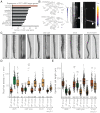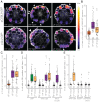Vascular transcription factors guide plant epidermal responses to limiting phosphate conditions
- PMID: 32943451
- PMCID: PMC7116379
- DOI: 10.1126/science.aay4970
Vascular transcription factors guide plant epidermal responses to limiting phosphate conditions
Abstract
Optimal plant growth is hampered by deficiency of the essential macronutrient phosphate in most soils. Plant roots can, however, increase their root hair density to efficiently forage the soil for this immobile nutrient. By generating and exploiting a high-resolution single-cell gene expression atlas of Arabidopsis roots, we show an enrichment of TARGET OF MONOPTEROS 5/LONESOME HIGHWAY (TMO5/LHW) target gene responses in root hair cells. The TMO5/LHW heterodimer triggers biosynthesis of mobile cytokinin in vascular cells and increases root hair density during low-phosphate conditions by modifying both the length and cell fate of epidermal cells. Moreover, root hair responses in phosphate-deprived conditions are TMO5- and cytokinin-dependent. Cytokinin signaling links root hair responses in the epidermis to perception of phosphate depletion in vascular cells.
Copyright © 2020 The Authors, some rights reserved; exclusive licensee American Association for the Advancement of Science. No claim to original U.S. Government Works.
Conflict of interest statement
Figures





Comment in
-
The secret of increased (root) hair density.Nat Rev Mol Cell Biol. 2020 Nov;21(11):657. doi: 10.1038/s41580-020-00302-0. Nat Rev Mol Cell Biol. 2020. PMID: 32994551 No abstract available.
References
-
- De Rybel B, et al. Plant development. Integration of growth and patterning during vascular tissue formation in Arabidopsis. Science. 2014;345 1255215. - PubMed
-
- De Rybel B, et al. A bHLH complex controls embryonic vascular tissue establishment and indeterminate growth in Arabidopsis. Dev Cell. 2013;24:426–437. - PubMed
-
- Ohashi-Ito K, Matsukawa M, Fukuda H. An atypical bHLH transcription factor regulates early xylem development downstream of auxin. Plant Cell Physiol. 2013;54:398–405. - PubMed
-
- Ohashi-Ito K, Oguchi M, Kojima M, Sakakibara H, Fukuda H. Auxin-associated initiation of vascular cell differentiation by LONESOME HIGHWAY. Development. 2013;140:765–769. - PubMed
Publication types
MeSH terms
Substances
Grants and funding
LinkOut - more resources
Full Text Sources
Other Literature Sources
Molecular Biology Databases
Research Materials

